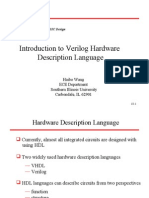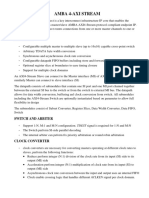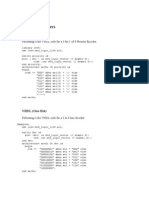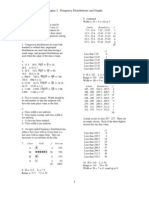0 ratings0% found this document useful (0 votes)
115 viewsVerilogTutorial1 ECE
This document provides an outline for a Verilog tutorial covering topics such as structural and behavioral modeling, variables, operators, complex statements, and testbenches. It includes examples for different Verilog concepts like case statements and loops. The tutorial consists of an introduction to logic circuits, a Verilog overview, and 3 labs - the first two involve designing and simulating a mux module at the behavioral and gate levels to compare the differences, while the third introduces the DE1 development board.
Uploaded by
Cu LucCopyright
© © All Rights Reserved
Available Formats
Download as PPT, PDF, TXT or read online on Scribd
0 ratings0% found this document useful (0 votes)
115 viewsVerilogTutorial1 ECE
This document provides an outline for a Verilog tutorial covering topics such as structural and behavioral modeling, variables, operators, complex statements, and testbenches. It includes examples for different Verilog concepts like case statements and loops. The tutorial consists of an introduction to logic circuits, a Verilog overview, and 3 labs - the first two involve designing and simulating a mux module at the behavioral and gate levels to compare the differences, while the third introduces the DE1 development board.
Uploaded by
Cu LucCopyright
© © All Rights Reserved
Available Formats
Download as PPT, PDF, TXT or read online on Scribd
You are on page 1/ 30
VERILOG TUTORIAL 1
DaNang University of Technology
Prepaired by:
Kien T.Nguyen, Lab Assistant
Thanh Vu, Lab Assistant
Anh H.D.Nguyen, Lab Assistant
AP-ECE
Materials
Tools:
Specification: Word, AbiWord, Open Office
RTL coding: HDL TurboWriter, Notepad++, Vim,
Emacs, conTEXT
Simulation: iVerilog, ModelSim, Quartus
Simulator, ISE Simulator
Synthesis: Quartus, Xilinx ISE
Website:
www.asic-world.com
www.dut.udn.vn/ece
References
EE271 A Brief Logic Tutorial, Brian J.Tocco
Stephen Brown, Fundamentals of Digital Logic
with Verilog, Verilog reference, App A.
Introductory Digital Systems Laboratory, MIT
Don Thomas, The Verilog Hardware Description
Language, Carnegie Mellon University.
IEEE Verilog 1364 - 1995
IEEE Verilog 1364 - 2001
EVITA-Verilog interactive tutorial (software)
Verilog Tutorial, www.asic-world.com
Lectures Outline
1. Introduction to logic circuit
2. Verilog Tutorial.
3. Lab 1: Design and simulate mux module.
4. Lab 2: Gate level vs behavior level
5. Lab 3: Introduction DE1 Kit
1.Introduction to logic circuit
A binary switch A Light controlled by a switch
Light = X
What is logic circuit ?
1.Introduction to logic circuit
(contd)
Light (Z) = X.Y Light (Z) = X + Y
Basic Logic gate, symbol & function
1.Introduction to logic circuit
(contd)
Z = X.Y
Z = X+Y
Z = X+Y = X.Y + X.Y Z = X+Y = X.Y + X.Y
1.Introduction to logic circuit (contd)
Truth table is a mathematics
table which is used to specify
the functionality of a digital logic
circuit.
Ex1: Check again !!
X Y X Y X.Y X.Y X+Y X+Y X+Y X+Y
0 0
0 1
1 0
1 1
1 1
1 0
0 1
0 0
Ex2: Think more!! And can you draw circuits?
x y z x.y.z x+y+z x.y + z (x+y).z
0
0
0
0
1
1
1
1
0
0
1
1
0
0
1
1
0
1
0
1
0
1
0
1
Truth Table in Digital circuit
1.Introduction to logic circuit (contd)
Decimal system: S={0;1;2;3;.;9};
123 = 1x10^2 + 2x10^1 + 2x10^0
Binary system: S = {0;1};
1001 = 1x2^3 + 0x2^2 + 0x2^1 + 1x2^0 = 8 + 1 = 9
Convert Decimal to Binary:
11 : 2 remain1
= 5 : 2 remain 1 => 1011
= 2: 2 remain 0
= 1:2 remain 1
=0
Practice covert 1101 to decimal, 15 to binary ?
2.Verilog Tutorial
2.1 Structural Models
2.2 Behavioral Models
2.3 Variable
2.4 Operator
2.5 Complex Statement
2.6 Testbench
2.1 Structural Models
Overview: also call Gate level Models
2.1 Structural Models (contd)
2.1 Structural Models (contd)
2.2 Behavioral Models
2.2 Behavioral Models (contd)
2.2 Behavioral Models (contd)
2.2 Behavioral Models (contd)
2.2 Behavioral Models (contd)
Sensitivity list
2.3 Variable
reg: store value until another value is assigned to
it. Ex: reg sda;
wire: connect signal together
time: 64 bit wide register use to store time value.
Only use in simulate
integer: 32 bit register
real: for store real numeric value
realtime: time value using real type
Arrays: Ex reg sda [7:0]; wire sda_wire [7:0];
Vector: Ex reg [7:0] sda;
2.4 Operator
Arithmetic Operators:
Addition +
Subtraction
Multiplication *
Division :
Modulo %
Relative Operators:
Lower <
Larger >
Lower or equal <=
Larger or equal >=
Read more in EVITA-Verilog: Chapter 5, Section 3
2.4 Operator (contd)
Equality operators
Equal: ==
Not equal: !=
Logical operators
And: && . Ex: A = 2; B = 0; A&&B = 0
Or: ||. Ex: A = 2; B = 0; A||B = 1
Not: !
Bitwise operators
And: & Ex: A = 2b10; B = 2b00; A&B = 2b00
Or: | Ex: A = 2b10; B = 2b00; A|B = 2b10
Not: ~ Ex: A = 2b10; B = ~A = 2b01
Xor: ^ Ex: A = 2b10; B = 2b00; A|B = 2b10
Xnor: ~^ Ex: A = 2b10; B = 2b00; A|B = 2b01
Read more in EVITA-Verilog: Chapter 5, Section 3
2.4 Operator (contd)
Redunction operators
And: & Ex: A = 4b1010; B = &A = A[3] & A[2] & A[1] &
A[0] = 1b0
Or: | Ex: A = 4b1010; B = |A = 1b1
Nand: ~& Ex: A = 4b1010; B = ~&A = 1b1
Nor: ~| Ex: A = 4b1010; B = ~|A = 1b0
Xor: ^ Ex: A = 4b1010; B = ^A = 1b0
Xnor: ~^ Ex: A = 4b1010; B = ~^A = 1b1
Shift operators
Shift left: <<
Shift right: >>
Concatenation and Replication Operators
Read more in EVITA-Verilog: Chapter 5, Section 3
2.5 Complex statements
Always and initial blocks (already know)
The if-else statement (already know)
The case statement
Loop statements
The case statement
module mux4_to_1 (out, i0, i1, i2, i3, s1, s0);
output out; input i0, i1, i2, i3;
input s1, s0;
reg out;
always @(s1 or s0 or i0 or i1 or i2 or i3)
begin
case ({s1, s0})
2'b00: out = i0;
2'b01: out = i1;
2'b10: out = i2;
2'b11: out = i3;
default: out = 1'bx;
endcase
end
endmodule
Loop statements
Why loop
integer count;
initial
begin
count = 0;
while (count < 128)
begin
$display("Count = %d", count);
count = count + 1;
end
end
For loop
integer count;
initial
begin
count = 0;
for (count = 0;count < 128; count = count
+1 )
begin
$display("Count = %d", count);
count = count + 1;
end
end
2.6 Test bench
UUT is an instance module which map to the
real modules for simulating
Test bench Mux model
dut
f
b
c
sel
stimulus
measure
mux_tb
Icarus Simulation
Compile verilog file to data
out file
Generate vcd file for
simulation
Run gtkwave simulation
with that vcd file
iverilog *.v
vvp a.out
gtkwave dump.vcd
See more in: How to run Icarus?
Lab 1
Coding mux module and mux_tb module using
notepad++.
Complile verilog file with iverilog
iverilog [path]/mux.v
Generate vcd file with vvp
vpp a.out
Simulation mux module in GTKWAVE
gtkwave dump.vcd
Save the result waveform to a picture
Lab 2
Coding gate level mux module using
notepad++. (Slide 10)
Compile, Simulation mux module in
GTKWAVE
Save result waveform to a picture. Compare
the results between Lab 1 and Lab 2. What are
differences? Why ? Why do we have to assign
the delay value ?
You might also like
- Dvcon Us 2021 Paper Making Your Dpi C Interface A Fast River of Data Redelman100% (1)Dvcon Us 2021 Paper Making Your Dpi C Interface A Fast River of Data Redelman22 pages
- Uop Sorbex Family of Technologies: James A. JohnsonNo ratings yetUop Sorbex Family of Technologies: James A. Johnson8 pages
- Week 8 Final Project Proposal - Operations Concept ManagementNo ratings yetWeek 8 Final Project Proposal - Operations Concept Management29 pages
- HC21 23 131 Ajanovic-Intel-PCIeGen3 PDFNo ratings yetHC21 23 131 Ajanovic-Intel-PCIeGen3 PDF61 pages
- A Practical Look at Systemverilog Coverage - Tips, Tricks, and GotchasNo ratings yetA Practical Look at Systemverilog Coverage - Tips, Tricks, and Gotchas11 pages
- Course Basic Uvm Session7 Monitors and Subscribers TfitzpatrickNo ratings yetCourse Basic Uvm Session7 Monitors and Subscribers Tfitzpatrick17 pages
- Implementation of DDR SDRAM Memory Controller For Embedded SOCNo ratings yetImplementation of DDR SDRAM Memory Controller For Embedded SOC5 pages
- PCI Express Basics & Background: Richard Solomon Synopsys100% (1)PCI Express Basics & Background: Richard Solomon Synopsys45 pages
- Beyond UVM: Creating Truly Reusable Protocol Layering: Abstract-Protocols That Are Transported by Other Lower-LevelNo ratings yetBeyond UVM: Creating Truly Reusable Protocol Layering: Abstract-Protocols That Are Transported by Other Lower-Level6 pages
- William Stallings Computer Organization and Architecture 9 EditionNo ratings yetWilliam Stallings Computer Organization and Architecture 9 Edition60 pages
- Verification of Driver Logic Using Ambaaxi UvmNo ratings yetVerification of Driver Logic Using Ambaaxi Uvm10 pages
- Tutorial On Transaction Level Modeling With Systemc For System Level DesignNo ratings yetTutorial On Transaction Level Modeling With Systemc For System Level Design151 pages
- IEEE 802.11ax - An: Osama Aboul-Magd Huawei Technologies, CanadaNo ratings yetIEEE 802.11ax - An: Osama Aboul-Magd Huawei Technologies, Canada30 pages
- Uvm: The Next Generation in Verification Methodology: Mark Glasser, Methodology Architect February 4, 2011No ratings yetUvm: The Next Generation in Verification Methodology: Mark Glasser, Methodology Architect February 4, 20116 pages
- William Stallings Computer Organization and Architecture 9 EditionNo ratings yetWilliam Stallings Computer Organization and Architecture 9 Edition52 pages
- Design of DDR4 SDRAM Controller - Ashraful Et. Al.No ratings yetDesign of DDR4 SDRAM Controller - Ashraful Et. Al.5 pages
- Chapter-1: 1.1. Serial Data TransmissionNo ratings yetChapter-1: 1.1. Serial Data Transmission44 pages
- A Coverage Driven Formal Methodology For Verification Sign Off PresentationNo ratings yetA Coverage Driven Formal Methodology For Verification Sign Off Presentation28 pages
- Impacts of Human-Wildlife Conflict in Developing C PDFNo ratings yetImpacts of Human-Wildlife Conflict in Developing C PDF6 pages
- Analysis of The Ladder Diagram A Packaging System With Petri NetsNo ratings yetAnalysis of The Ladder Diagram A Packaging System With Petri Nets6 pages
- Pierrot Lunaire and The Resistance To Theory100% (1)Pierrot Lunaire and The Resistance To Theory6 pages
- The End of The World: Maria Manuel LisboaNo ratings yetThe End of The World: Maria Manuel Lisboa224 pages
- A+ Blog-Class-8-First Bell-Physics-Chapter-5-Class-29-Notes (Em)No ratings yetA+ Blog-Class-8-First Bell-Physics-Chapter-5-Class-29-Notes (Em)3 pages
- No Number of Part Quantity Description Applicability DesignationNo ratings yetNo Number of Part Quantity Description Applicability Designation208 pages
- TLD (X) Cannot Dismount Drive X, Slot X Already Is FullNo ratings yetTLD (X) Cannot Dismount Drive X, Slot X Already Is Full4 pages
- Chapter 2 - Frequency Distributions and Graphs: Limits Boundaries FNo ratings yetChapter 2 - Frequency Distributions and Graphs: Limits Boundaries F20 pages
- Long Intl Intro To CII Adv Work Packaging-An Industry Best PracticeNo ratings yetLong Intl Intro To CII Adv Work Packaging-An Industry Best Practice15 pages
- Files & Document Storage: External Fortran MCQ DeviceNo ratings yetFiles & Document Storage: External Fortran MCQ Device7 pages
- Dvcon Us 2021 Paper Making Your Dpi C Interface A Fast River of Data RedelmanDvcon Us 2021 Paper Making Your Dpi C Interface A Fast River of Data Redelman
- Uop Sorbex Family of Technologies: James A. JohnsonUop Sorbex Family of Technologies: James A. Johnson
- Week 8 Final Project Proposal - Operations Concept ManagementWeek 8 Final Project Proposal - Operations Concept Management
- A Practical Look at Systemverilog Coverage - Tips, Tricks, and GotchasA Practical Look at Systemverilog Coverage - Tips, Tricks, and Gotchas
- Course Basic Uvm Session7 Monitors and Subscribers TfitzpatrickCourse Basic Uvm Session7 Monitors and Subscribers Tfitzpatrick
- Implementation of DDR SDRAM Memory Controller For Embedded SOCImplementation of DDR SDRAM Memory Controller For Embedded SOC
- PCI Express Basics & Background: Richard Solomon SynopsysPCI Express Basics & Background: Richard Solomon Synopsys
- Beyond UVM: Creating Truly Reusable Protocol Layering: Abstract-Protocols That Are Transported by Other Lower-LevelBeyond UVM: Creating Truly Reusable Protocol Layering: Abstract-Protocols That Are Transported by Other Lower-Level
- William Stallings Computer Organization and Architecture 9 EditionWilliam Stallings Computer Organization and Architecture 9 Edition
- Tutorial On Transaction Level Modeling With Systemc For System Level DesignTutorial On Transaction Level Modeling With Systemc For System Level Design
- IEEE 802.11ax - An: Osama Aboul-Magd Huawei Technologies, CanadaIEEE 802.11ax - An: Osama Aboul-Magd Huawei Technologies, Canada
- Uvm: The Next Generation in Verification Methodology: Mark Glasser, Methodology Architect February 4, 2011Uvm: The Next Generation in Verification Methodology: Mark Glasser, Methodology Architect February 4, 2011
- William Stallings Computer Organization and Architecture 9 EditionWilliam Stallings Computer Organization and Architecture 9 Edition
- Design of DDR4 SDRAM Controller - Ashraful Et. Al.Design of DDR4 SDRAM Controller - Ashraful Et. Al.
- A Coverage Driven Formal Methodology For Verification Sign Off PresentationA Coverage Driven Formal Methodology For Verification Sign Off Presentation
- Impacts of Human-Wildlife Conflict in Developing C PDFImpacts of Human-Wildlife Conflict in Developing C PDF
- Analysis of The Ladder Diagram A Packaging System With Petri NetsAnalysis of The Ladder Diagram A Packaging System With Petri Nets
- A+ Blog-Class-8-First Bell-Physics-Chapter-5-Class-29-Notes (Em)A+ Blog-Class-8-First Bell-Physics-Chapter-5-Class-29-Notes (Em)
- No Number of Part Quantity Description Applicability DesignationNo Number of Part Quantity Description Applicability Designation
- TLD (X) Cannot Dismount Drive X, Slot X Already Is FullTLD (X) Cannot Dismount Drive X, Slot X Already Is Full
- Chapter 2 - Frequency Distributions and Graphs: Limits Boundaries FChapter 2 - Frequency Distributions and Graphs: Limits Boundaries F
- Long Intl Intro To CII Adv Work Packaging-An Industry Best PracticeLong Intl Intro To CII Adv Work Packaging-An Industry Best Practice
- Files & Document Storage: External Fortran MCQ DeviceFiles & Document Storage: External Fortran MCQ Device

























































































